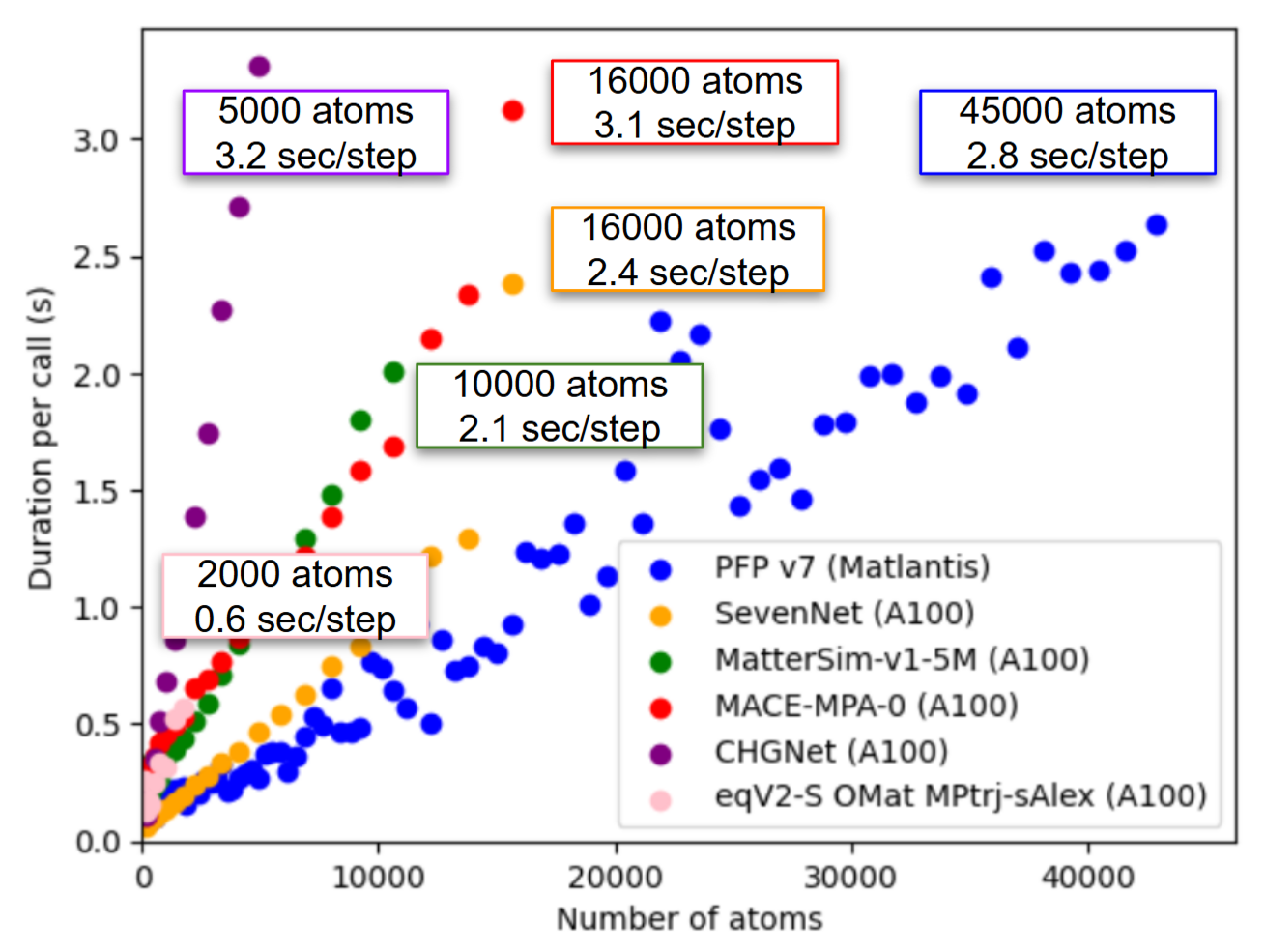Comparison with Open Source MLIP
Machine Learning Interatomic Potentials (MLIPs) are AI models that learn complex atomic interactions and reproduce chemical phenomena with high accuracy. As development accelerates, a competitive landscape has emerged, with major companies and research institutions worldwide vying to advance this innovative technology. PFP, the core technology behind Matlantis, has been under development since 2019 as one of the earliest efforts to build a universal MLIP. In this report, we present validation results comparing the performance of PFP against leading open-source MLIPs (OSS-MLIPs).
Accuracy of Calculations for Physical Properties
MLIP learns the forces acting on atoms and the energy of a system. However, from a practical perspective in materials development, how accurately it can predict real-world physical properties is important. Therefore, when evaluating the performance of a general-purpose MLIP, particularly one that aims to be applied to a variety of materials, it is important to verify not only the forces and energies directly learned, but also the accuracy of predicting various physical properties. Here, we compare PFP and OSS-MLIP for lattice thermal conductivity and surface energy, which are properties of practical importance.
Comparison of accuracy of lattice thermal conductivity
Lattice thermal conductivity is not only an important property in engineering, but also a stringent benchmark for evaluating MLIPs, as its calculation requires high-order derivatives of the potential energy surface. In this study, we predicted lattice thermal conductivity using PFP and several OSS-MLIPs, and compared the results with DFT data from the PhononDB-PBE dataset. Prediction errors were quantified using the mean Symmetric Relative Error (mSRE) for lattice thermal conductivity and the mean Symmetric Relative Mean Error (mSRME) for individual phonons—where lower values indicate higher accuracy. Table 1 summarizes the results. PFP demonstrated higher accuracy than other OSS-MLIPs in predicting lattice thermal conductivity.
Table 1. Comparison of lattice thermal conductivity prediction accuracy between PFP and OSS-MLIP
| mSRE (↓) | mSRME (↓) | |
| PFP v6 (distance 0.03 Å) | 0.530 | 0.656 |
| PFP v6 (distance 0.1 Å) | 0.245 | 0.374 |
| MACE-L (Ref.) | 0.710 | 0.935 |
| MACE-L (distance 0.03 Å) | 0.719 | 0.932 |
| MACE-L (distance 0.1 Å) | 0.694 | 0.915 |
| MatterSim-v1 (Ref.) | 0.413 | 0.575 |
| MatterSim-v1 (distance 0.03 Å) | 0.413 | 0.575 |
| MatterSim-v1 (distance 0.1 Å) | 0.366 | 0.541 |
For a detailed analysis, please see our Lattice Thermal Conductivity Calculation.
Surface energy accuracy comparison
In practical materials development, researchers work not only with ideal crystal structures of inorganic materials, but also with more complex configurations such as surfaces and interfaces. These structures often exhibit unique energetic characteristics, making surface energy a critical physical property. In this study, we predicted surface energies using PFP and OSS-MLIPs, and compared the results to DFT values from the CHIPS-FF Surface Energy dataset. The results, shown in Table 2, demonstrate that PFP achieves surface energy predictions with accuracy comparable to the best-performing methods.
Table 2. Accuracy of surface energy predictions by PFP and OSS-MLIP
| Model name | MAE (J/m²) |
| PFP v7 | 0.19 |
| eqV2_31M_omat_mp_salex | 0.17 |
| eqV2_31M_omat | 0.18 |
| eqV2_86M_omat_mp_salex | 0.18 |
| eqV2_153M_omat | 0.19 |
| eqV2_86M_omat | 0.20 |
| orb-v2 | 0.18 |
| MatterSim-v1 | 0.36 |
Check out our Surface Energy Benchmarks for more information.
Calculation Number of Atoms and Speed Comparison
Modeling key phenomena in real-world materials development—such as reactions and diffusion at interfaces—requires more than just tracking the behavior of a small number of atoms. Therefore, when evaluating the performance of an MLIP, the number of atoms it can simulate and its computational speed are critical performance metrics.
Here, we present a comparison of PFP and five other MLIPs in terms of the maximum number of atoms that can be simulated and computational speed. PFP was executed on the Matlantis platform, while the other MLIPs were run using an NVIDIA A100 GPU (80 GB memory) with the ASE Calculator. For each method, calculation speed was measured as the average time required to compute atomic forces over 10 iterations.
As a result, PFP was able to handle 3 to 20 times more atoms than other OSS-MLIPs, and also achieved the fastest computation times when simulating the same number of atoms. These results suggest that PFP enables large-scale simulations that are impractical with OSS-MLIPs, as well as simulations of complex phenomena that were previously beyond the reach of conventional methods. This capability is expected to accelerate both the understanding of complex materials behavior and the accurate prediction of physical properties.
